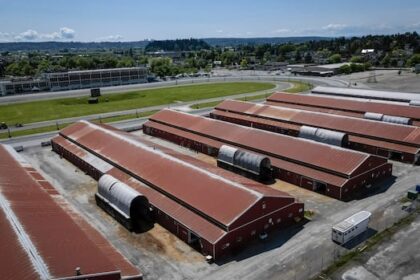Manitoba Premier Wab Kinew has been dropping hints the province could soon look to position itself as a leader in what some commentators are calling the “fourth industrial revolution.” Speaking on a politics and current events podcast in late October, Kinew hinted at three upcoming megaprojects that would help accelerate Manitoba’s transition to a “have province … not 40 years in the future, [but] within the next five or 10 years.” One would be the much-hyped proposed upgrades to the Port of Churchill, which would transform Canada’s northernmost deepwater port into a vital trade hub and help strengthen the country’s hold on Arctic sovereignty. The other two projects mentioned on the Herle Burly podcast hosted by Canadian political strategist David Herle were more ambiguous, though Kinew hinted the province was looking to become a bigger player in the energy and tech sectors. “Any tech play at a large scale is basically an energy play, and so we have a lot of low-carbon electricity in Manitoba and I think that’s going to be one of our competitive advantages,” Kinew said. Manitoba Hydro has warned for years that electricity generating capacity is running scarce and new energy sources will be needed to maintain reliability while keeping pace with rapidly growing demand. Meanwhile, the province is championing energy-hungry AI data centres. Photo: Tim Smith / The Narwhal Days later, the province announced it had received the first report from its newly minted innovation and productivity task force, which made recommendations to help Manitoba navigate the economic shift from “a system rooted in physical production of tangible goods, into a new economy in which wealth, power and security are rooted in the ownership of intangible assets like intellectual property, data and artificial intelligence.” After releasing the report, Kinew was even more direct: “You’ll see servers and data centres in Manitoba in the future,” he told reporters. Until recently, few people paid much attention to the machines behind the curtain — the physical infrastructure within which our pixelated world is intricately tied together. But the last few years have seen that infrastructure — namely data centres — take centre stage in the charge to spur economic development. Anything that exists on the internet, or in the ever-nebulous “cloud,” is stored on a physical computer somewhere. Most likely that computer is inside a data centre — usually a warehouse-like building. Photo: Jenny Kane / Associated Press Governments, including Canada’s, have invested hundreds of billions of dollars into new data centre construction; big tech companies like Meta, Amazon and Alphabet (Google) intend to spend upwards of $350 billion this year alone. Data centres have been announced, planned and built in cities across North America at an unrelenting pace. In the United States, economists estimate data centres and other information and technology infrastructure accounted for 92 per cent of the country’s gross domestic product growth in the first half of the year — driven by the explosion in artificial intelligence research and advancement — while the rest of the economy sat relatively stagnant. But the sprawling data centres being built for artificial intelligence across the United States have come with their share of concerns. Some worry the ballooning investments could quickly spiral into an economic bubble; communities near a supersized data centre in Georgia have reported their taps running dry and drinking water turning to sludge; cities in artificial intelligence hubs like Virginia have seen their power bills skyrocket as data centres suck up huge portions of the electricity grid. Against that backdrop and amid mounting concerns on how the energy sector and environment will be directly impacted, Kinew seems prepared to launch Manitoba into the tech-sector arms race. But is Manitoba ready to take its place in the AI revolution? Table of Contents First things first: what’s a data centre? Does Manitoba have any data centres? How much power does a data centre use? Are these AI data centres bad for the environment? Can Manitoba’s grid handle data centres? Why is Wab Kinew talking about data centres? What are other provinces doing? What’s on the horizon for Manitoba? First things first: what’s a data centre? Anything that exists on the internet, or in the ever-nebulous “cloud,” is stored on a physical computer somewhere. Most likely that computer is inside a data centre. “All the internet is, is someone else’s computer,” John Anderson, a computer science professor at the University of Manitoba who has spent his career researching artificial intelligence, said. “A data centre is a large collection of computers that is used usually for a particular purpose, but not necessarily for only one purpose, in an installation in one place.” Those purposes can range from internet searches to email storage, video streaming, online banking, social media and, most recently, building and training artificial intelligence. Currently, it’s estimated there are more than 11,000 data centres worldwide, with about 250 in Canada. As much as 40 per cent of data centre energy consumption goes toward powering intensive — and thirsty — water cooling systems. Photo: Mike Deal / Winnipeg Free Press While data centres are a buzzword of late, they aren’t new technology. The concept has been around since the 1940s, though they were called mainframe computers at the time. As technology evolved, computers got smaller. But then the internet arrived on the scene and data centres became critical to powering the digital world’s unquenchable thirst for information. Currently, it’s estimated there are more than 11,000 data centres worldwide, with about 250 in Canada. For the most part, these data centres are nondescript buildings comprising rows of cabinets, called racks, with hundreds of computers stacked on top of another and often wired together. Those server racks need to be powered at all times, so data centres typically have both an on-site power distributor and a back-up generator. Finally — and critically — data centres are equipped with powerful cooling systems to keep the technology at optimal temperatures and humidity levels. Data centres come in a few different flavours. Universities, governments and some businesses often have in-house centres — a climate-controlled office space that stores that institution’s servers, data and other IT equipment. Then there are larger retail data centres that lease server racks to customers at a price-per-kilowatt rate. Universities, governments and some businesses often have in-house centres — a climate-controlled office space that stores that institution’s servers, data and other IT equipment, like this one in Manitoba. Photo: Winnipeg Free Press files An example would be Amazon’s data centres, Anderson said. “They’re used to run all of the traffic for their sales and logistics, they’re used to stream their TV programs and media,” he said. “They’re also rented out as computer power for people to simply buy and use. I’ve had graduate students that have done all their AI research on Amazon’s machines to save me having to buy them and keep them upgraded in the lab.” The larger, for-rent data centres have recently been eclipsed by the “hyper-scale” centre — megafacilities built by big-tech companies to handle their own immense data needs. In many cases, these centres are being used to train and power artificial intelligence, which requires exponentially more computing power than, say, sending an email to grandma. Back to top Does Manitoba have any data centres? Yes. Statistics Canada currently lists eight data centres in Manitoba, not including sites at businesses or public institutions. Seven are in Winnipeg, one is in Winkler. Most are on the smaller side. About half are owned by Les.net, a retailer with a handful of server rooms in the downtown Exchange District. Bell MTS, Canada’s largest telecom provider, built a 7.5-megawatt data centre in the city’s south end in 2015, which has since been acquired by Equinix. There are no hyperscale-sized, AI-focused data centres in the province yet. Back to top How much power does a data centre use? Data centres are ravenous for electricity. That energy need is typically expressed in power capacity, which the University of Manitoba’s Anderson describes as the maximum amount of power needed to run the IT infrastructure and cooling equipment. Traditional data centres built for the dot-com boom of the 2000s have a capacity of about five to 10 megawatts, equivalent to the power draw of about 8,000 homes. But the complex computer chips used for artificial intelligence have prompted a dramatic spike in power demand, with a typical AI rack using at least 10 times as much power as an old-school web server. Specialized computer chips for artificial intelligence are faster — and more power-hungry — than traditional computer chips. Photo: Seth Wenig / Associated Press Hyper-scale centres have power capacities of at least 100 megawatts; the mega-facilities commissioned by tech giants like Amazon and Meta will require upwards of 1,000 megawatts to run. According to the International Energy Agency, power demand for data centres has grown about 12 per cent each year since 2017, reaching 415 terawatt-hours — about 1.5 per cent of global energy consumption — in 2024. The agency predicts energy demand will more than double by 2030, consuming about 40 per cent more electricity than Canada currently generates in a year. Back to top Are these AI data centres bad for the environment? As hyperscale centres continue to sprout across the globe, critics have raised concerns about their expanding environmental footprint. “We know that data centres consume large amounts of energy and water, and we know that consumption is only going to grow, which will mean more greenhouse gas emissions and greater stress on water supplies,” Martin Krause, a director with the United Nations Environment Programme, said in a June release outlining new guidelines for data centre procurement. According to the International Energy Agency, the electricity used to power centres generated 180 million tonnes of carbon dioxide equivalent emissions in 2024 — more than double the annual emissions from Canada’s oilsands. As data centres continue to get bigger and more power hungry, the energy agency projects emissions will reach between 300 and 500 million tonnes by 2035, making them some of the “fastest growing sources of emissions.” The electricity consumption of AI data centres is project to grow. In Manitoba, that electricity mostly comes from hydro power at the moment, but new generation may rely on fossil fuels to meet rapidly rising demand. Photo: Tim Smith / The Narwhal In Canada and the United States, most of the power comes from a mix of renewable sources, like hydroelectricity and natural gas (a smaller share comes from nuclear power and burning coal). Writing for the Canadian Climate Institute, researcher Kate Harland notes these massive data centre projects can incentivize provinces to expand their electricity grids with renewable resources, “enabling the bigger, cleaner, smarter electricity system necessary to decarbonize the Canadian economy.” But, she adds, provincial electricity grids across the country are already reaching their limits, and the increased demand from data centres could exacerbate concerns of power shortages or rate hikes. If provinces turn to fossil fuel sources to meet that demand — like Manitoba’s planned investment in new gas-powered generators — it could undo efforts to decarbonize the grid. As much as 40 per cent of data centre energy consumption goes toward powering intensive — and thirsty — water cooling systems. “If you have a server room like you would have in the university’s computer services department, you would need to have specialized air conditioning in there to deal with all the heat the computers are throwing,” Anderson said. “If you’re dealing with a really intense one … where the computers are very close together, you need to effectively pump cold water around them.” The University of Manitoba’s supercomputer data centre, called Grex, recycles waste heat into nearby campus buildings. Photo: Supplied by the University of Manitoba These larger centres use a maze of cold water-filled pipes nestled within the server racks to draw heat away from the computer equipment. In some cases, that water is then pumped into a cooling tower and evaporated, which requires a constant flow of up to 19,000 litres per minute. Other data centres use a closed-loop cooling system, which cycles the water back through a large refrigerator and uses significantly less water in the process. While companies have been tight-lipped about the exact water use of their hyper-scale facilities, a study by the Lawrence Berkeley National Laboratory in California estimated American data centres consumed 64 billion litres for cooling alone in 2023, a little more than Winnipeg’s total billed water use for a year. Many of these centres use freshwater for cooling, prompting concerns they could exacerbate drought conditions or strain limited drinking water availability in some regions. In response, companies are looking for more efficient solutions. The University of Manitoba’s super computer data centre, for example, uses a water-cooling system that recycles the excess heat into nearby campus buildings. Other data centres are strategically built in cold climates, where free air-cooling systems can replace water cooling during the winter months. Back to top Can Manitoba’s grid handle data centres? “Any large new load has the potential to impact our system, whether it be a data centre, foundry or manufacturing facility,” Manitoba Hydro media relations officer Peter Chura said in a written response to questions from the Free Press and The Narwhal. Asked whether data centres, in particular, would strain the province’s grid, Chura said: “The best answer is ‘possibly.’ ” The Crown utility has warned for years that generating capacity is running scarce and new energy sources will be needed by 2029 to maintain reliability while keeping pace with rapidly growing demand. In 2023, an internal memo at the utility warned energy-intensive customers could quickly drain remaining capacity; the year prior, the province issued a moratorium on cryptocurrency data centres to save space in the grid. The Manitoba Hydro Kettle Generating Station spans the Nelson River. Indigenous communities have long borne the frontline impacts of hydroelectricity development in Manitoba’s north. Photo: Tim Smith / The Narwhal Even the province’s electric supply backstop, the Midcontinent Independent System Operator market, which regulates power sales between Manitoba and 15 American states, has struggled to meet rising demand. In its most recent rate application to the Public Utilities Board, Hydro noted it was impacted by “congestion” in the cross-border market during drought conditions in late 2023. “A major factor contributing to the congestion … was the Atlas Power Data Center, a cryptocurrency mining operation,” Manitoba Hydro wrote in its filings. Despite the capacity concerns, Manitoba Hydro isn’t factoring data centres, in particular, into its future resource plans. Nor is it suggesting that new infrastructure is entirely off the table. “We factor in a wide variety of potential future growth scenarios into our load planning. This includes residential growth, growth from electrification, economic development objectives including data centres and projects already approved and in the pipeline,” Chura said. “We have fielded some requests from data centres, along with other commercial and industrial facilities that require larger amounts of power. Obviously, as this is commercially sensitive information, we cannot say more than that.” Manitoba Hydro’s responses to questions from the public utilities board, however, show the province has received 13 data centre connection requests, currently under various stages of review. At least one has signed a service contract with the utility. Back to top Why is Wab Kinew talking about data centres? In short: data is power in today’s economy, and building centres on home soil gives political leaders more control over how that information is managed. Speaking to the Manitoba Chambers of Commerce after the release of the innovation task force report, Kinew stressed that home-grown data infrastructure is critical to keeping sensitive, personal data safe. “How do we keep your privacy, so that our kids and grandkids will be able to develop as individuals and have that freedom to express themselves in a way that is truly free in the future of our society?” Kinew said. “Well, it probably means that we should stop sending all of our information south of the border.” Privacy isn’t the only motivation. Kinew has characterized data centres, AI and other big-tech investments as economic drivers for the province. During construction, these facilities can create upwards of 1,000 jobs for electricians, engineers and technical specialists (though facilities typically employ far fewer people once complete and operational). Anderson says investing in data centres and other AI technologies in Manitoba will generate more opportunities for students like his who are being “highly trained in doing future work.” Canadian companies like Bell and Telus are keen to expand their data centre infrastructure and develop “sovereign AI” — that is, Canadian owned and operated platforms — with support from the federal government’s $2.4 billion AI Sovereign Compute Strategy. “If we do not own and control the facilities, networks and compute capacity where this data resides, the benefits will flow outward. Data and compute sovereignty is therefore not a technical detail but a defining question for Canada’s future prosperity and Manitoba’s leadership within it,” the innovation task force report said. Manitoba Premier Wab Kinew is adamant data centres will help transform Manitoba into a “have” province, rather than a “have-not” province. “You’ll see servers and data centres in Manitoba in the future,” he said recently. Photo: Ruth Bonneville / Winnipeg Free Press Manitoba’s lobby records show Kinew met with lobbyists from Bell Canada in April and October to discuss “telecommunications, connectivity, investment and emerging technology including AI in Manitoba.” In May, Bell announced plans to build six AI data centres in British Columbia; in August the company announced it would partner with AI platform Buzz HPC to install NVIDIA computer chips — hardware used for artificial intelligence systems — in its Canadian data centres, starting with its five-megawatt facility in Manitoba. This motivation is only bolstered by the idea that Manitoba is an ideal location for a data centre. In the late aughts, when the frenzy first swept the continent, the tech and telecom companies designing these facilities set their sights on Manitoba as a “new frontier” for these facilities, and the sentiment persists today. Firstly, the province’s infamously long, cold winters allow tech companies to save money cooling server rooms. More importantly: Manitoba boasts some of the cheapest, low-emission hydroelectricity in the country, making the region attractive for power-hungry infrastructure developers. Finally, the innovation task force notes the Port of Churchill gives Manitoba a strategic advantage, connecting the province to global markets. “If you’re using a lot of energy and it’s energy that is green-generated — or something close to it — then you can greater justify the use,” Anderson says. “That would be the advantage of doing this in Manitoba.” The Manitoba Hydro Kettle Generating Station on the Nelson River just outside Gillam, Man. Manitoba has long relied largely on dams to generate electricity. The Manitoba premier says that fact — along with Manitoba’s cold winters — make it a prime location to build energy-hungry data centres that must be kept from over-heating. Photo: Tim Smith / The Narwhal Kinew recognizes this advantage, and he’s aiming to leverage that into economic opportunities for the province. “Power is the most important thing in the world right now. Everyone needs electricity. And Donald Trump gets a lot of his power, politically speaking, from the tech industry,” he told the Globe and Mail during an interview in late September. “We’re all hungry to power AI data centres. And we have a choice to make about how we’re going to use that next 500 megawatts in our province. Do we continue to guarantee it for the U.S., or are we going to build up our own domestic economy, which may mean building more housing, more manufacturing, more mining projects? We’re saying we’re going to bet on Manitoba.” Back to top What are other provinces doing? Several provinces have marketed themselves open for AI and data centre business — particularly those with hydroelectric resources. British Columbia’s Crown utility offered an electricity rate discount for centres in 2022 and was fully subscribed within a year. Hydro Quebec began marketing itself to data centre developers in 2016 and landed investments from Amazon, Google, Microsoft and IBM. Alberta has taken a different approach, relying on its natural gas resources, low tax rates and deregulated electricity grid to make the province the “most attractive place to build artificial intelligence data centres in North America.” As of June, Alberta’s Electric System Operator had received nearly 30 project applications with a combined demand of 16 gigawatts — nearly 10 times the electric load of the city of Edmonton. As concern over electricity demand outpacing supply has grown, amplified by unpredictable weather conditions and droughts that make supply less certain for hydroelectric operators, those same jurisdictions are starting to restrict access to the grid. In October, the B.C. government announced it would introduce legislation to limit the amount of power available to AI and data centre projects, while outright banning new cryptocurrency mines. Alberta has put a temporary cap on large-scale data centre connections while it sorts through the existing queue. Ontario and Quebec are limiting data centre connections to projects that bring local economic benefits, with the latter no longer chasing AI investments. Back to top What’s on the horizon for Manitoba? In March, Manitoba introduced its own legislation to give government officials more power to decide which major projects can plug into the grid. Bill 28 will allow the province’s finance minister to tell Manitoba Hydro whether a development requesting a “large supply of power” should be prioritized, and require the utility to deny requests that are “not reasonably feasible.” It also gives the province power to define a “large supply of power.” That means the future of Manitoba’s data centre and artificial intelligence landscape is largely in the hands of its politicians — and those politicians are signalling significant interest. While Kinew won’t give away details about any planned data centre projects, he’s hinted more details could be made clear in the coming weeks. Pressed for details of the upcoming megaprojects he mentioned to Herle in October, as well as his meetings with Bell lobbyists earlier that month, Kinew told CBC News to “check out the state of the province address this December.” Back to top Julia-Simone Rutgers is a reporter covering environmental issues in Manitoba. Her position is part of a partnership between The Narwhal and the Winnipeg Free Press. Recent Posts Pretty much everything you need to know about Manitoba’s new obsession with AI data centres Nov. 14, 2025 17 min. read Manitoba — home of much hydro power and notoriously cold winters — says it’s perfectly… Fast-track or fake-track? Sorting hype from reality in Carney’s major projects blitz Canada’s list of nation-building projects just got longer — but the federal fast-track isn’t everything… Ksi Lisims LNG is on Carney’s nation-building list. Here’s what you need to know Nov. 13, 2025 6 min. read Prime Minister Mark Carney’s support for the floating Ksi Lisims facility, backed by the Nisga’a…
Pretty much everything you need to know about Manitobas new obsession with AI data centres












